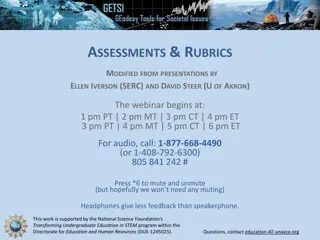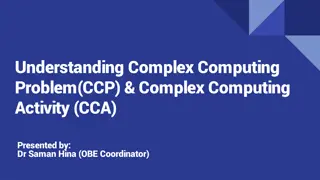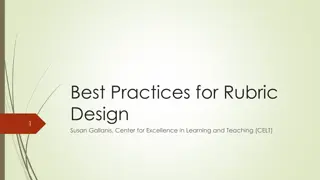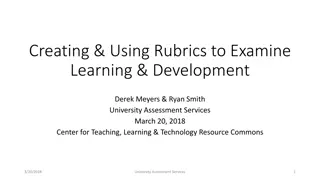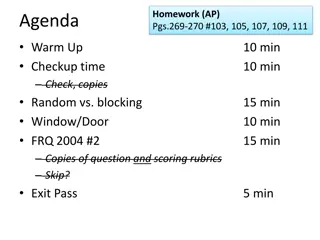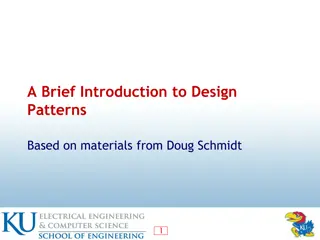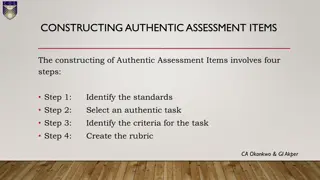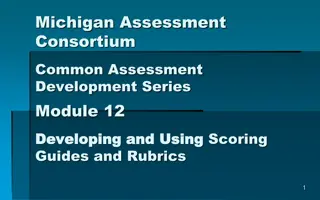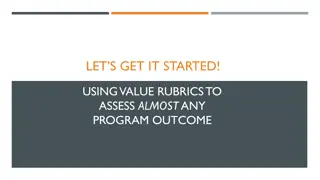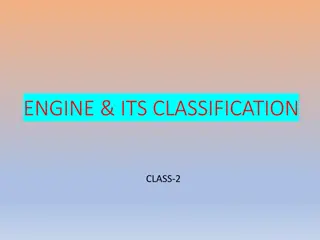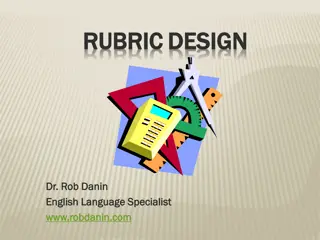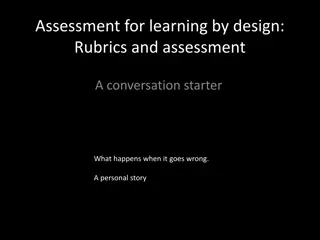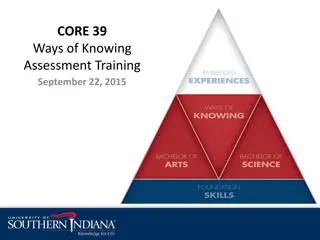Action Research Data Collection Methods Overview
Explore quantitative data collection methods such as checklists, rubrics, surveys, and rating scales for action research in education. Learn how these tools are used to assess student performance and gather valuable insights for refining teaching strategies. Discover the key characteristics and appl
4 views • 12 slides
Understanding Software Analysis and Design Process
Software analysis and design involve a systematic approach to understanding user requirements, creating logical models, and transitioning to detailed design specifications. Requirements analysis focuses on capturing system requirements, while design translates these requirements into implementation
7 views • 16 slides
ASSESSMENTS & RUBRICS
Enhance your understanding of assessments and rubrics in STEM education through a comprehensive webinar covering terminology, proposal strategies, and practical usage of materials design rubrics. Delve into setting learning goals, aligning outcomes, and designing instructional strategies for success
1 views • 25 slides
Assessment Workshop at American Samoa Community College
Explore the process of assessment, including topics like rubrics, reliability, validity, data analysis, direct vs. indirect assessments, and examples of learning outcomes. Discover the strengths and methods of creating rubrics to evaluate student work effectively.
0 views • 74 slides
Understanding Complex Computing Problem (CCP) and Complex Computing Activity (CCA)
Dr. Saman Hina, along with Dr. Farrukh Arif and Dr. Maria Waqas, presents information on Complex Computing Problem (CCP) - a problem involving technical, computing, and other issues with no obvious solution, requiring deep knowledge and analytical thinking. CCP is evaluated through predefined rubric
4 views • 19 slides
Guidelines for Design of Cement Concrete Pavement and Interlocking Paver Blocks
This document provides guidelines for designing cement concrete pavements and interlocking paver blocks, covering factors governing design, wheel loads, design period, subgrade characteristics, approximate k values based on CBR values, and the importance of a sub-base below concrete pavements. It em
0 views • 67 slides
Software Engineering Design Principles and Concepts
The chapter discusses the essential principles and concepts in software design, highlighting the four key design models - data design, architectural design, interface design, and component-level design. It emphasizes the importance of traceability to the analysis model, minimizing the gap between so
0 views • 36 slides
Rubrics and Authentic Assessments in Course Evaluation at Qatar University
Workshop focused on developing rubrics for assessing courses at Qatar University College of Arts and Sciences. It covers the rationale for using rubrics, different assessment types, challenges of authentic assessment, and the role of rubrics in ensuring consistency and reliability in evaluating stud
0 views • 14 slides
Best Practices for Rubric Design in Teaching
Explore the key components of rubrics, understand their importance in assessment, and learn how to effectively design and use them to enhance student learning outcomes.
0 views • 18 slides
Understanding and Utilizing Rubrics for Assessment
A rubric is a scoring tool that outlines specific expectations for evaluating assignments or projects. This tool helps in identifying key criteria for assessment and provides a structured approach to grading. Rubrics play a vital role in enhancing learning outcomes and promoting consistency in evalu
0 views • 26 slides
Enhancing Feedback Strategies in ELA Learning Project Day
Refine understanding of ELA, engage with student exemplars, and design constructive feedback in a structured agenda. Activities include generating feedback, digging deeper into feedback processes, and considering the impact of timely and specific feedback on student growth in learning and skills. Co
0 views • 31 slides
Multi-State Collaborative for Advancing Quality Student Learning
Slides showcasing results from the demonstration year (2015-2016) of the Multi-State Collaborative for Advancing Quality Student Learning involving 12 states. Study findings reflect the use of common rubrics to assess student work and highlight the challenges and benefits of the VALUE rubrics. Facul
2 views • 32 slides
Comprehensive Guide to Kindergarten Writing Training for NYSESLAT 2019
Explore a detailed guide on Kindergarten Writing Training for the NYSESLAT 2019 exam. The training covers four constructed-response types including Letter Writing, Word Writing, Sentence Writing, and Writing a Story. Gain insights into the application of holistic writing rubrics, analyzing student r
0 views • 24 slides
AP Statistics Homework Agenda and Experimental Design Example
In this AP Statistics homework agenda, students work on warm-up questions, checkups, and a controlled experiment design example involving paper airplanes and natural light impact on test scores. The agenda covers various topics such as confounding variables, random vs. blocking, and controlled exper
0 views • 15 slides
Understanding System on Chip (SoC) Design and Components
Explore the world of System on Chip (SoC) design, components, and working flow. Learn about Intellectual Properties (IP), platform-based design, typical design flows, top-down design approach, and the emerging Electronic System Level (ESL) design flow. Discover the essential components of an SoC, su
0 views • 45 slides
Exploring Design Inspiration and Elements in Costume and Fashion Design
Dive into the world of costume and fashion design through a visual journey of finding design inspiration, understanding the design process, emphasizing originality, and exploring different sources of creativity. Discover how technology, art, food, history, architecture, and nature can spark innovati
0 views • 45 slides
Enhancing Piping Design Efficiency with Spec-Driven Technology
Explore how Spec-Driven Piping technology powered by CADACTIVE offers a standardized approach for piping design in Creo Parametric. This innovative extension streamlines design communication, eliminates errors, and improves design efficiency by utilizing a master catalog, automated checking capabili
0 views • 15 slides
Material Design: Combining Classic Design Principles with Technological Innovation
Material Design is a design language that combines traditional design principles with the possibilities offered by technology and science. It emphasizes visual language, classic design elements, and innovation to create delightful user experiences. The Material Metaphor, Imagery, Typography, Color,
0 views • 34 slides
Comprehensive Guide to System Design Components and Techniques
System design involves the detailed planning and identification of components in an information system, aiming to provide users with a general understanding of the new system. This process includes techniques like flowcharts, prototyping, and component design, covering aspects such as output design,
0 views • 24 slides
Enhancing Student Success Through Inclusive Assignment Design
Effective assignment design is crucial for student success, particularly for first-generation and underrepresented students. Clear instructions, transparent rubrics, and inclusive assessment approaches are key factors in promoting learning outcomes and reducing biases. Inclusive assignments should a
0 views • 15 slides
Understanding Design Patterns: A Comprehensive Overview
Exploring the world of design patterns, this content delves into the essence of design patterns, their application in software design to resolve complexity, and the different types of design patterns - creational, structural, and behavioral. It also showcases examples of popular design patterns such
0 views • 22 slides
Understanding Basic Concepts in Software Design
Software design involves transforming customer requirements into a form suitable for implementation, with activities categorized into preliminary and detailed design stages. High-level design focuses on module identification and control relationships, while detailed design entails defining data stru
1 views • 24 slides
Understanding Micro Rubrics in Educational Assessment
A micro rubric is a detailed assessment tool used at the end of learning activities to evaluate student performance and guide self-reflection. It consists of levels ranging from "Not Submitted" to "Excelling" and helps students improve their work through targeted feedback. Micro rubrics differ from
0 views • 6 slides
Mastering Rubrics: Types, Design, and Application
Understand the essentials of rubrics by exploring various types like checklists, rating scales, Likert-type scales, holistic, and analytic rubrics. Learn about the characteristics of good rubrics and how to create effective scoring guides. Get insights from examples like the University of Pittsburgh
0 views • 9 slides
Exploring 3D Design and Critical Analysis in Architecture
Dive into the world of 3D design and critical analysis with a focus on architecture. Discover the stages of design, essential skills for designers, and areas of study in three-dimensional design. Delve into iconic buildings like Frank Lloyd Wright's Falling Water, analyze their key features, and eve
0 views • 9 slides
Understanding Design Patterns in Object-Oriented Design
Design patterns in object-oriented design (OOD) are essential templates that codify best practices for solving common problems. They help streamline development by capturing proven design decisions, promoting code reuse, and enhancing system flexibility and modularity. Learn about the core concepts,
0 views • 20 slides
Constructing Authentic Assessment Items: A Guide in 4 Steps
Constructing authentic assessment items involves four steps: identifying standards, selecting an authentic task, defining criteria, and creating a rubric. Standards are specific skills and knowledge students should gain. Tasks should reflect these standards. Criteria measure student mastery. Rubrics
0 views • 25 slides
Understanding Interaction Design in Human-Computer Interaction
Interaction design focuses on creating interactive products that are easy, effective, and enjoyable to use. It aims to reduce negative user experiences while enhancing positive ones. Designing interactive products requires understanding user activities, interfaces, and device arrangements to support
0 views • 11 slides
SE2811 Software Component Design Overview
This course covers software component design, design patterns, object-oriented design, algorithms, and opportunities for reuse in systems design. It emphasizes the importance of domain-level design and provides insights into solving core problems through reusable classes.
0 views • 21 slides
Developing and Using Scoring Guides and Rubrics in Assessment
Explore the importance of rubrics and scoring guides in assessment development, understanding different types of rubrics, developing and using them effectively, and addressing bias through objective criteria. Learn how rubrics help in evaluating student responses and providing feedback for improveme
0 views • 52 slides
Analysis of Bunch Lengthening in CEPC for Different Design Parameters
This study explores bunch lengthening in the Circular Electron Positron Collider (CEPC) for various design parameters, analyzing a 54 km design scheme, a 61 km design scheme, and a 100 km design scheme. The analysis includes the theoretical framework used, equations for bunch lengthening, and conclu
1 views • 15 slides
Understanding Plain & Reinforced Concrete Structures in Design Engineering
In the design of Plain & Reinforced Concrete structures, various strength design methods such as Ultimate Strength Design (USD) and Allowable Strength Design (ASD) are utilized. These methods involve factors of safety, material strength, load factors, and analysis in the elastic range. Additionally,
0 views • 11 slides
Understanding Value Rubrics for Comprehensive Program Assessment
Explore the use of VALUE rubrics for assessing program outcomes, creating aligned assignments, collecting student work effectively, and improving student skills. Learn about AAC&U's 15 VALUE rubrics and their applications in course and program evaluation. Discover how to define performance level
0 views • 24 slides
Verilog Adder Examples & Typical IC Design Flow
This comprehensive content delves into Verilog adder examples, typical IC design flow, physical design considerations, and examples of OpenGL ES GPU and ARM hypervisor applications. It covers the fundamentals of digital logic with Verilog design, hardware description language, FPGA prototyping, phys
0 views • 27 slides
Understanding the Importance of Software Design for Data Scientists
Today's ISEA Session 2 with David Beck from the University of Washington delves into the critical role of intentional software design for data scientists. The session covers the software design approach, user-centric design stories, use cases, components, testing strategies, and the benefits and dra
0 views • 76 slides
Understanding Engine Classification and Design
Engine classification involves categorizing engines based on various factors such as combustion type, number of strokes, cylinder design, and ignition method. Common classifications include external and internal combustion engines, as well as categories based on the design and use of the engine. Add
0 views • 11 slides
Mastering Rubric Design for Effective Assessment
Rubrics are essential tools in evaluating and providing feedback on student performance. This comprehensive guide covers the definition, elements, and benefits of rubrics, along with expert tips on designing impactful rubrics for various assessments. Explore the art of rubric design, learn what make
0 views • 30 slides
Enhancing Assessment Practices Through Rubrics and Conversational Learning
Explore the critical aspects of rubrics in assessment design, including the distinction between holistic and analytical rubrics, their respective applications, and how they can be leveraged as learning tools. Discover the importance of aligning rubrics with course objectives and engaging students in
0 views • 10 slides
Streamlining the CORE 39 Assessment Process: A Closer Look at Rubrics and Deadlines
A detailed insight into the CORE 39 assessment process, focusing on the creation of rubrics aligned with key assignments. Learn about the formation of the CORE 39 Assessment Task Force and the use of Tk20 software for assessment. Important deadlines and the role of rubrics in grading are highlighted
0 views • 23 slides
Enhancing Assessment Practices through Effective Rubrics Design
Explore the importance of well-designed rubrics in assessment practices, focusing on avoiding pitfalls and maximizing student understanding. Learn how to create powerful rubrics that guide students towards essential learning outcomes. Gain insights on improving assessment strategies and fostering cl
0 views • 17 slides


